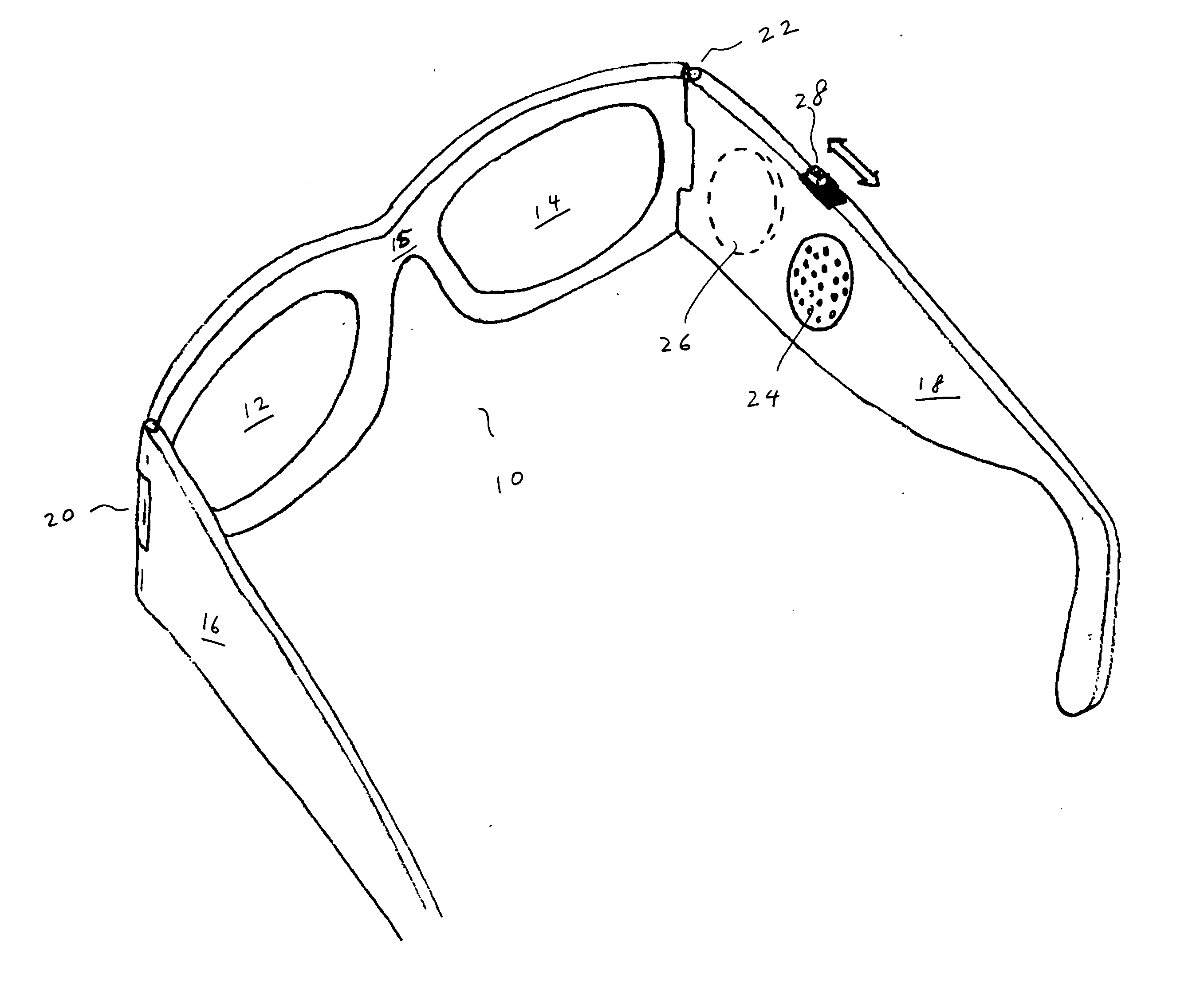Event eyeglasses
a technology of eyeglasses and spectacles, applied in the field of eyeglasses, can solve the problems of static information printed on the pen, inability to change, and only having so much space for a company
- Summary
- Abstract
- Description
- Claims
- Application Information
AI Technical Summary
Benefits of technology
Problems solved by technology
Method used
Image
Examples
embodiment 10
[0049] Referring back to FIG. 1, the embodiment 10 includes a speaker 24 that is at least partially embedded into the glasses. There are different approaches to embed an electrical component, such as a speaker, into different types of glasses. A number of approaches are described, for example, in the various related patent application noted above.
[0050] In one embodiment, the pair of glasses 10 shown in FIG. 1 includes a radio, and the speaker is a part of the radio. All the electronics for the radio are at least partially embedded in the glasses. For example, the electronics can be on a printed circuit board, and the board is in one of the temples of the glasses. Information is provided to the user through the radio. The radio can be an AM or a FM receiver. In one embodiment, the receiver is pretuned to the frequencies of the transmitter of the information. Or, before the glasses are distributed, the radio is set to receive signals from a specific frequency band. Also the radio may...
embodiment 300
[0089]FIG. 7A shows an embodiment 300 with a wheel 302 (roller) having clear strips, 304, 306 and 308, alternating with black strips, 310, 312 and 314, and two photodiodes, 316 and 318. Most of the wheel 302 and the two diodes, after incorporated into the temple 320, are covered by a piece of material 322. The two diodes, 316 and 318, are exposed to ambient light through a clear window 324. A part of the wheel 302 is extended out of the temple 320, allowing the wheel 302 to be turned about its axis 326. The wheel 302 can have teeth for friction turning. As the wheel 302 rotates about the axis 326, based on the differential outputs from the diodes, the direction of movement of the wheel 302—clockwise or counterclockwise—is determined. For example, if the wheel 302 is rotated clockwise, the top diode 316 senses light before the bottom 318 senses light. On the other hand, if the wheel 302 is rotated counterclockwise, the bottom diode 318 senses light before the top 316. Based on the si...
embodiment 350
[0090]FIG. 7B shows an embodiment 350 with a wheel 352 having black 354 and reflecting 356 strips, two photodiodes, 358 and 360, and a LED 362. Again, most of the wheel, the two diodes and the LED are covered by a sheet of material 364. If a reflecting strip 356, instead of a black strip 354, goes over a diode, more light from the LED will be reflected back and received by the diode. If a black strip 354 goes over a diode, output from the diode will be significantly reduced. Again based on the signals from the diodes, the direction of rotation can be determined, which, in turn, can be used to indicate incrementing or decrementing outputs.
PUM
 Login to View More
Login to View More Abstract
Description
Claims
Application Information
 Login to View More
Login to View More - R&D
- Intellectual Property
- Life Sciences
- Materials
- Tech Scout
- Unparalleled Data Quality
- Higher Quality Content
- 60% Fewer Hallucinations
Browse by: Latest US Patents, China's latest patents, Technical Efficacy Thesaurus, Application Domain, Technology Topic, Popular Technical Reports.
© 2025 PatSnap. All rights reserved.Legal|Privacy policy|Modern Slavery Act Transparency Statement|Sitemap|About US| Contact US: help@patsnap.com



